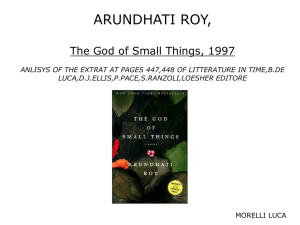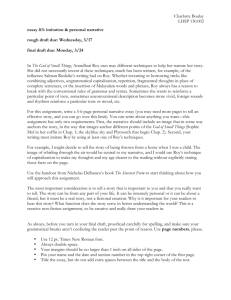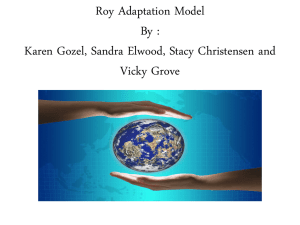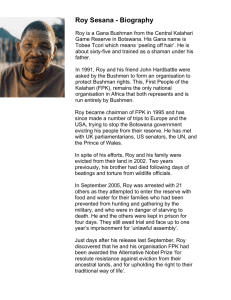Critical Race Theory in The God of Small Things
advertisement
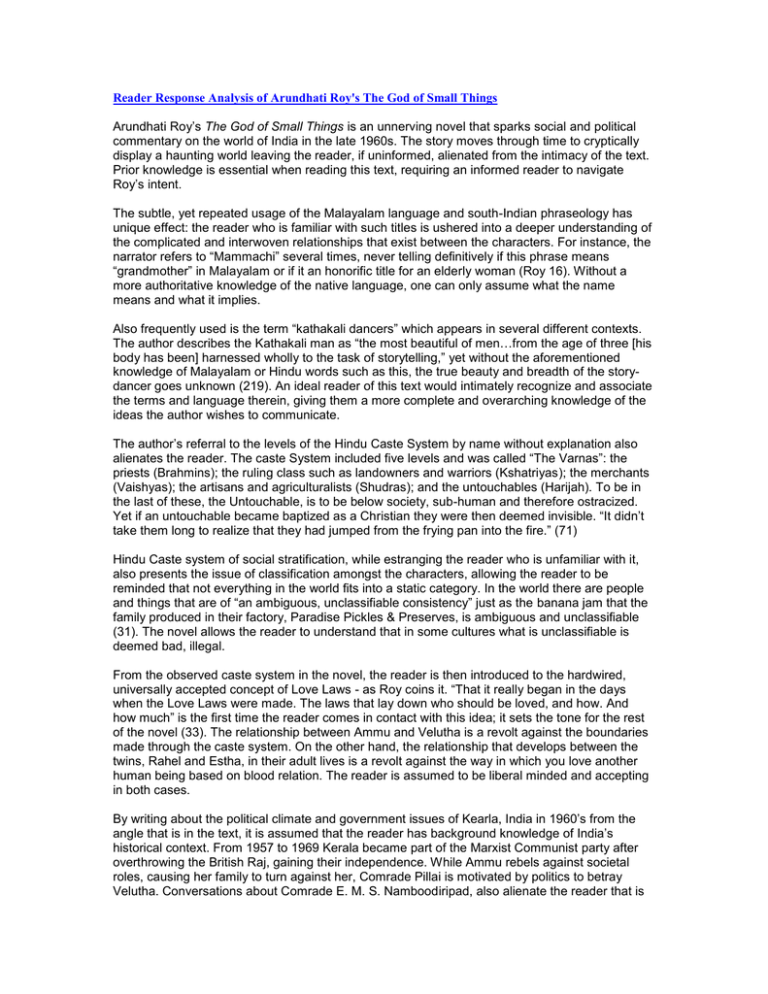
Reader Response Analysis of Arundhati Roy's The God of Small Things Arundhati Roy’s The God of Small Things is an unnerving novel that sparks social and political commentary on the world of India in the late 1960s. The story moves through time to cryptically display a haunting world leaving the reader, if uninformed, alienated from the intimacy of the text. Prior knowledge is essential when reading this text, requiring an informed reader to navigate Roy’s intent. The subtle, yet repeated usage of the Malayalam language and south-Indian phraseology has unique effect: the reader who is familiar with such titles is ushered into a deeper understanding of the complicated and interwoven relationships that exist between the characters. For instance, the narrator refers to “Mammachi” several times, never telling definitively if this phrase means “grandmother” in Malayalam or if it an honorific title for an elderly woman (Roy 16). Without a more authoritative knowledge of the native language, one can only assume what the name means and what it implies. Also frequently used is the term “kathakali dancers” which appears in several different contexts. The author describes the Kathakali man as “the most beautiful of men…from the age of three [his body has been] harnessed wholly to the task of storytelling,” yet without the aforementioned knowledge of Malayalam or Hindu words such as this, the true beauty and breadth of the storydancer goes unknown (219). An ideal reader of this text would intimately recognize and associate the terms and language therein, giving them a more complete and overarching knowledge of the ideas the author wishes to communicate. The author’s referral to the levels of the Hindu Caste System by name without explanation also alienates the reader. The caste System included five levels and was called “The Varnas”: the priests (Brahmins); the ruling class such as landowners and warriors (Kshatriyas); the merchants (Vaishyas); the artisans and agriculturalists (Shudras); and the untouchables (Harijah). To be in the last of these, the Untouchable, is to be below society, sub-human and therefore ostracized. Yet if an untouchable became baptized as a Christian they were then deemed invisible. “It didn’t take them long to realize that they had jumped from the frying pan into the fire.” (71) Hindu Caste system of social stratification, while estranging the reader who is unfamiliar with it, also presents the issue of classification amongst the characters, allowing the reader to be reminded that not everything in the world fits into a static category. In the world there are people and things that are of “an ambiguous, unclassifiable consistency” just as the banana jam that the family produced in their factory, Paradise Pickles & Preserves, is ambiguous and unclassifiable (31). The novel allows the reader to understand that in some cultures what is unclassifiable is deemed bad, illegal. From the observed caste system in the novel, the reader is then introduced to the hardwired, universally accepted concept of Love Laws - as Roy coins it. “That it really began in the days when the Love Laws were made. The laws that lay down who should be loved, and how. And how much” is the first time the reader comes in contact with this idea; it sets the tone for the rest of the novel (33). The relationship between Ammu and Velutha is a revolt against the boundaries made through the caste system. On the other hand, the relationship that develops between the twins, Rahel and Estha, in their adult lives is a revolt against the way in which you love another human being based on blood relation. The reader is assumed to be liberal minded and accepting in both cases. By writing about the political climate and government issues of Kearla, India in 1960’s from the angle that is in the text, it is assumed that the reader has background knowledge of India’s historical context. From 1957 to 1969 Kerala became part of the Marxist Communist party after overthrowing the British Raj, gaining their independence. While Ammu rebels against societal roles, causing her family to turn against her, Comrade Pillai is motivated by politics to betray Velutha. Conversations about Comrade E. M. S. Namboodiripad, also alienate the reader that is unfamiliar with his part in the political climate at the time. These and other references cause the uninformed reader a greater sense of alienation as he or she progresses through the novel. The ideal reader would have the necessary understanding of language, cultural traditions, and political biases. Although this understanding is not required for a novice reader, it does make the interaction with the text more intimate rather than foreign and unattainable. Cultural Criticism of The God of Small Things Over time humans have created a complex system of cultural mores in order to assist in the categorization of life and assign meaning to events as well as defining behavior and perception. Ironically, the very system of norms and mores that humans create to help structure their world ends up structure them. Arundhati Roy's God of Small Things gives readers a deeper view into the way cultural norms and mores shape and define personal character. For the main characters of the novel, both India's caste system as well as the Love Laws change and mold, not only the events of the story, but the characters themselves. The reader is expected to already have knowledge of India’s government and caste system from the late 60’s until 1993. The book, however, reveals an insight into the everyday cultural norms of the four main characters and descriptively portrays how the caste system affected each of them directly. Ammu (Rahel and Estha’s mother) breaks the “norm” as a rebellious teenager and aged adult. Because she was victimized by her father and ex-husband Ammu, a defiant woman, is now repressed and tense to any type of authority as well as inept when expressing any type of love towards her children. She then has a heated affair with an Untouchable worker at her family’s pickle factory, which by all means is not condoned by India’s caste system. This brief and voluntary affair on both ends eventually sends Velutha, the other party to the affair, to an early death in jail. There were characters in the novel that were the most rigid and vicious in their attempts to uphold the social codes and class tensions; however, characters such as Ammu and Velutha were the most unconventional and daring to untie it. Consequently they are punished severely for their disobedience. The rigid societal bonds of the caste system cause the characters of The God of Small Things to yield to other laws that permeate throughout the novel’s pages. A cultural code of ethical relationships; the Love Laws are violated by many of the main characters leading to woes of great proportion. The reader is first made aware of this concept in chapter one, page 33, when it is said by the narrator “that it really began in the days when the Love Laws were made. The laws that lay down who should be loved and how. And how much.” These love laws had their basis in the Indian caste system, and rightful relationships were seen as ones that did not violate the social standing of the individual. In the novel, the characters Estha, Rahel, Ammu, and Velutha are the prime violators of these culturally designed relationships. For Estha and Rahel, first it is their public love of Velutha that is considered unacceptable because he belongs to the class of untouchables. This relationship with an untouchable is also seen with their mother, Ammu, who enters into a sexual relationship with him, as mentioned earlier. Much later in the novel, we are then presented with another situation in which the narrator says; “Only that once again they broke the Love Laws. That lay down who should be loved. And how. And how much” (Roy 311). This scene is that of an incestuous night of lust between Estha and Rahel that, rather than being out of lust, is an action that is the result of their mutual grief. This was a violation not of the Love Laws that designated who a person could love in the terms of class, but of how family members love one another. These two cultural barricades display a traditional discourse that resonates in the setting of the story. This novel speaks to the gray area that lies between a cultural belief in a nefarious black and pristine white; the injustice that arises when strict social divisions are enforced. Challenging the ideology that caste systems and love laws are appropriate, The God of Small Things eradicates the idea that social obedience is for the greater good – displaying rather the evidence of victims; slaughtered, lost, and unloved in a society that does not care and does not love. Critical Race Theory in The God of Small Things Sex and race are always useful and mentioned with intention in texts. In Arundhati Roy’s novel The God of Small Things there is a clear intention to the use of sex and race to keep and rid of the main key characters in the novel. The character or characters who engage in unlawful sexual acts are punished while unwanted or undesired race is purged. In this Indian society that worships England, Love Laws, and the Caste System race and sex creates intra-racial racism within the Indian communities that is reinforced with force through the government and Caste System. Intra-racial racism is a result of internalized racism while internalized racism is a result of Anglophilia. The God of Small Things depicts this concept clearly through its woven story of creatures and culture. “They were a family of Anglophiles.” (Roy 51) Through manipulating a character list of mixed races, Roy creates a dynamic between the white race and brown race. Internalized racism reigns as the characters believe in white superiority. When posing for a portrait, Pappachi’s choice of attire resembles that of an English horseback rider even “though he had never ridden a horse in his life.” (Roy 50). Beyond attire, Pappachi firmly believed in the Englishman’s nobility. Ammu attempted to explain her husband’s infidelity through his willingness to give Ammu to Mr. Hollick to be “looked after” to Pappachi (Roy 41). He “would not believe her story – not because he thought well of her husband, but because he didn’t believe that an Englishman, any Englishman, would covet another man’s wife.” (Roy 42). Pappachi would believe an Indian being adulterous but he regards the English so highly, an Englishman would be incapable of such a travesty – hence the Englishman is more honorable, decent, and virtuous than an Indian man. Roy also places emphasis on the characters that are of the white race. The household waits in anticipation for the arrival of the English child, Sophie Mol, and her mother Margaret – an English woman that Chacko married. She left Chacko for a more appealing Englishman named Joe. Baby Kochamma’s love of a white Irishman, Father Mulligan, is another character introduced that is idealized through her infatuation. Rahel as well marries an American and relocated to Boston, only to return to Ayemenem after their divorce. The Indian relationship that is depicted in the book is between Pappachi and Mammachi, Babba and Ammu – both relationships suffer from horrible conditions: abuse of alcohol, bad tempers, and/or beatings. This displays the lack of honor or virtue by the Indian males and a stronger argument that the Englishman is superior. This internalized racism grows becoming more than a feeling of inferiority to the English. It transforms into intra-racial racism – a discrimination within the Indian community. Darker Indians are looked down upon while paler Indians, such as Sophie Mol, who is in fact half English half Indian, reign with superiority. She even states, “You're both whole wogs and I'm a half one.”(Roy 17). A wog is an insulting British term for inferiors, displaying Sophie Mol’s belief that she is better because she is English and paler than the twins, Estha and Rahel. In The God of Small Things, the author makes clear that the Indian main characters have internalized the supposed superiority of the white people and then project this view upon the darker within their culture. Moreover, the depth of color and its association within inferiority reaches its pinnacle within The God of Small Things through the character of Velutha. Despite Velutha’s birth into the Untouchable caste, the author makes clear that the foremost distinction in Velutha is his dark color. As Rahel watches the Communist march from the car window she notices “a white shirt over a black back with a birthmark” and identifies this back as Velutha’s through the birthmark but also his distinctively dark complexion (Roy 76). In fact, Velutha is given his name “which means white in Malayalam, because he was so black” (Roy 70). Through the almost worship of Sophie Mol and, to some degree, Margaret, the meager acceptance of Ammu, and the castigation of Velutha, the reader begins to form a hierarchy of color where lightness is praised and darkness is mistrusted and illtreated. Additionally, throughout the story there are references to Africa, especially amongst the twins and Velutha, yet when Rahel says to Kochu Maria that she will eventually be living in Africa, Kochu Maria responds saying “Africa’s full of ugly black people and mosquitoes,” showing disdain for people of dark color (Roy 175). The correlation between blackness and vice becomes even more entangled when the character of Kari Saipu is introduced as the “Black Sahib”. This man had taken a young boy as his lover and then killed himself when the child was taken away, leading to the connection of even the word black as something taboo (Roy 51). When Sophie Mol drowns it is Velutha, who was not even present when the accident occurred, who is blamed and then brutally beaten, and dies in prison. There can be no doubt that, though his position in the caste system sets him aside culturally, Velutha’s uniquely dark color consecrates him visually as unclean and unworthy. In conclusion, intra-racial racism can be seen in The God of Small Things through the hierarchal distinction of skin color in India. This can be seen in relation to the caste system as well as the family structure. Anglo traits in a person make them worthy of worship while dark skin reduces a person to the lowest degree. One can see this most specifically, as noted above, in the characters of Sophie Mol and Velutha, characters who are polar opposites in the novel and are treated so. Postcolonial Theory & The God of Small Things The simple experience of being lost, the realization that there is no place of belonging and no ability to create a space that feels overwhelmingly of home, unhomeliness is experienced by the twins, Rahel and Estha in an astounding way in the novel The God of Small Things. They continue through the novel, adrift in an unending quest for stability, fighting the inner voice of double consciousness while stagnated by the outside chaos of hybridity. Estha, upon his return to Ayemenem wanders the streets of the town and then explores greater distances in surrounding areas. He is different, not speaking to anyone, a “psychological refugee” suffering from the world that has been imposed upon him (Tyson 421). “He walked through the world like a chameleon. Never revealing himself, never appearing not to. Emerging through the chaos unscathed.”(Roy 15). It is arguable that Estha at this point could not reveal himself to anyone because he didn’t have an understanding of who he actually was. By this point Estha has grown to a man but has suffered from double consciousness since his early childhood. Rahel is much the same. She is unable to maintain a relationship with her husband due to the results of her double consciousness. Because of the double consciousness inflicted on her, Rahel only felt at home and stable with Estha who mutually floundered through his existence. “What Larry McCaslin saw in Rahel’s eyes was not despair at all, but a sort of enforced optimism. And a hollow where Estha’s words had been. He couldn’t be expected to understand that. That the emptiness in one twin was only a version of the quietness in the other.” This double consciousness has cultivated through experiences as children that alienated them from a defined sense of self. They were capable of speaking their native language, Malayalam, but when they chose to speak it they were reprimanded. They were forced to speak English and “they had to form the words properly” (Roy 36) even though “it [Malayalam] was the language everyone spoke in Kerala” (Roy 58). Not only was language conflicted but religion was as well. During the narrative, Chacko tells the children a creation story centered on the “Earth Woman” which is contradictory to the biblical ideas of Syrian Christianity, the religion of Ammu and Baby Kochamma. Baby Kochamma referred to the twins as, “Half-Hindu Hybrids” emphasizing the religion based conflict within each twin (Roy 44). The twins also fall victims to the continual home discussions of Anglophilia. Through a learned love of the conquering nation, Great Britain, the children are raised among people who idealize what is foreign rather than the native elements that surround them. The twins are made to feel inferior in comparison to their English cousin, Sophie Mol. Even Chacko debates before the twins that “Our dreams have been doctored. We belong nowhere. We sail unanchored on troubled seas. We may never be allowed ashore.” This statement emphasizes his belief that they are all foreign to their native land, suffering from the complex hybridity that has occurred from colonization. They suffer from the feeling of being destitute among what really should be considered their homeland. Even through the course of the novel, Estha and Rahel never have a true home to belong to. The Ayemenem House, where the extensions of the family consistently flocked to was, “their maternal grandmother’s house, where they really had no right to be.”(Roy 44). The book The God of Small Things continually cycled around the idea of rights: the right to love and be loved, the right to childhood innocence, and the right to a stable sense of self. All of which are things that are lost to the twins Estha and Rahel through their experiences, traveling through their own hearts of darkness. God of Small Things: From The Critics Posted: August 3, 2007 in Arundhati Roy, Book Review 0 Jennifer Howard Arundhati Roy’s rich, humid fairy tale of a novel begins in June, when the monsoon rains send the province of Kerala, in southwestern India, into fecund frenzy: “The countryside turns an immodest green … Pepper vines snake up electric poles. Wild creepers burst through laterite banks and spill across the flooded roads.” Behind this lush life, however, something festers. Rahel Kochamma, one of the novel’s twin protagonists, returns to her family home in the Kerali town of Ayemenem, and decay slithers out to greet her. The house walls “bulged a little with dampness that seeped up from the ground. The wild, overgrown garden was full of the whisper and scurry of small lives. In the undergrowth a rat snake rubbed itself against glistening stone.” This slithering overripeness hints at what’s really rotten in Ayemenem: the past, specifically a chain of events set in motion on “a skyblue day in December sixty-nine (the nineteen silent),” when the twins’ halfEnglish cousin, Sophie Mol, came to visit. Two weeks later Sophie was dead, drowned in Ayemenem’s river, leaving behind a shattered family and a terrible secret. The narrative eddies along toward the secret of Sophie’s death, but ultimately it flows into the drowning depths of history. The God of Small Things is a story of forbidden, cross-caste love and what a community will do to protect the old ways. The Kochamma family business, Paradise Pickles and Preserves, is emblematic of the theme. Ayemenem is practically pickled in history. Roy, an architect and screenwriter who grew up in Kerala, capably shoulders the burdens of caste and tradition, a double weight that crushes some of her characters and warps others, but leaves none untouched. Roy takes up classic material, but she delights in verbal innovation and stylistic tricks. She runs words together — “thunderdarkness,” “echoing stationsounds” — and plucks nouns from verbs and verbs from thin air. And she has hit on a striking way of getting at a child’s point of view (told in third person, the story unfolds more or less as young Rahel and Estha experience it). When her mother tells a rambunctious Rahel to “Stoppit,” Rahel “stoppited.” At Sophie’s funeral, a bat alights on a mourner: “the singing stopped for a ‘Whatisit?’ ‘Whathappened?’ and for a Furrywhirring and a Sariflapping.” At times it feels as though you’ve dropped into a faux Rushdie novel, with cartwheeling corpses and talking statues. Mostly, though, Roy’s verbal exuberance is all her own, and it makes The God of Small Things a real pleasure. History’s lessons may be bitter, but Roy serves them up fresh, pungent and delicious. — Salon Publishers Weekly With sensuous prose, a dreamlike style infused with breathtakingly beautiful images and keen insight into human nature, Roy’s debut novel charts fresh territory in the genre of magical, prismatic literature. Set in Kerala, India, during the late 1960s when Communism rattled the age-old caste system, the story begins with the funeral of young Sophie Mol, the cousin of the novel’s protagonists, Rahel and her fraternal twin brother, Estha. In a circuitous and suspenseful narrative, Roy reveals the family tensions that led to the twins’ behavior on the fateful night that Sophie drowned. Beneath the drama of a family tragedy lies a background of local politics, social taboos and the tide of history all of which come together in a slip of fate, after which a family is irreparably shattered. Roy captures the children’s candid observations but clouded understanding of adults’ complex emotional lives. Rahel notices that “at times like these, only the Small Things are ever said. The Big Things lurk unsaid inside.” Plangent with a sad wisdom, the children’s view is never oversimplified, and the adult characters reveal their frailtiesand in one case, a repulsively evil powerin subtle and complex ways. While Roy’s powers of description are formidable, she sometimes succumbs to overwriting, forcing every minute detail to symbolize something bigger, and the pace of the story slows. But these lapses are few, and her powers coalesce magnificently in the book’s second half. Roy’s clarity of vision is remarkable, her voice original, her story beautifully constructed and masterfully told. Library Journal This “piercing study of childhood innocence lost” mirrors the growing pains of modern India. Twin sister and brother Rahel and Estha are at the center of a family in crisis and at the heart of this “moving and compactly written book.” (LJ 4/15/97) Kirkus Reviews A brilliantly constructed first novel that untangles an intricate web of sexual and caste conflict in a vivid style reminiscent of Salman Rushdie’s early work. The major characters are Estha and Rahel, the fraternal twin son and daughter of a wealthy family living in the province of Kerala. The family’s prosperity is derived from a pickle factory and rubber estate, and their prideful Anglophilia essentially estranges them from their country’s drift toward Communism and their “inferiors’ ” hunger for independence and equality. The events of a crucial December day in 1969—including an accidental death that may have been no accident and the violent consequences that afflict an illicit couple who have broken “the Love Law”—are the moral and narrative center around which the episodes of the novel repeatedly circle. Shifting backward and forward in time with effortless grace, Roy fashions a compelling nexus of personalities that influence the twins’ “eerie stealth” and furtive interdependence. These include their beautiful and mysteriously remote mother Ammu; her battling “Mammachi” (who runs the pickle factory) and “Pappachi” (an insufficiently renowned entomologist); their Oxford-educated Marxist Uncle Chacko and their wily “grandaunt” Baby Kochamma; and the volatile laborite “Untouchable” Velutha, whose relationship with the twins’ family will prove his undoing. Roy conveys their explosive commingling in a vigorous prose dominated by odd syntactical and verbal combinations and coinages (a bad dream experience during midday nap-time is an “aftermare”) reminiscent of Gerard Manly Hopkins’s “sprung rhythm,” incantatory repetitions, striking metaphors (Velutha is seen “standing in the shade of the rubber trees with coins of sunshine dancing on his body”) and sensuous descriptive passages (“The sky was orange, and the coconut trees were sea anemones waving their tentacles, hoping to trap and eat an unsuspecting cloud”). In part a perfectly paced mystery story, in part an Indian Wuthering Heights: a gorgeous and seductive fever dream of a novel, and a truly spectacular debut. Synopsis “Dazzling…remarkable. A novel that turns out to be as subtle as it is powerful.” –The New York Times “This outstanding novel is a banquet for all the senses we bring to reading.” –Newsweek Winner of the prestigious Booker Prize in 1997, The God Of Small Things was a stunning debut for Arundhati Roy. Roy’s craftsmanship, highly original style, and intricate structure struck a chord with reviewers and readers alike. An international bestseller, this exquisite novel will surely be remembered — and reread — in years to come. It is a work that “makes you catch your breath, that changes the way you view life and its hidden complexities.” (Earth Times) Set in Kerala, India, in 1969, The God Of Small Things is the story of seven-year-old twins Rahel and Estha, born of a wealthy family and literally joined at the soul. Rahel and Estha are cared for by a host of compelling characters: their beautiful mother, Ammu, who has left a violent husband; their Marxist uncle, Chacko, still pining for his English wife and daughter who left him; their prickly grandaunt, Baby Kochamma, pickling in her virginity; and the volatile Veluth, a member of the Untouchable caste. When Chacko’s ex-wife, Margaret, and lovely daughter, Sophie, unexpectedly return, the household is thrown into disarray. Tragedy strikes in the form of an accident (that may not have been accidental) and a terrifying murder. Tremendously powerful and lushly romantic, The God Of Small Things effectively shifts between two time periods: Rahel’s present-day trip home to see her mute, haunted twin brother, and a December day 20 years before — the tumultuous day that tears the family apart. With mesmerizing language that brings to mind such authors as Salman Rushdie, Gabriel García Márquez, and William Faulkner, The God Of Small Things ambitiously tackles such profound issues as family, race, and class, the dictates of history, and the laws of love. Rahel and Estha learn too soon that love and life can be lost in a millisecond. To the Western reader, The God Of Small Things is both exotic and familiar, written in a sensual language that’s entirely fresh and invigorated by the Asian Indian influences of myth and culture. God of Small Things: The Lawlessness of Love Posted: August 3, 2007 in Arundhati Roy, Book Review 0 To read Arundhati Roy’s first novel, The God of Small Things, is to remind oneself how large the gods that dispense literary talent can be: Roy writes with extraordinary grace, creating a world so vivid and strangely beautiful that reading it is akin to entering a mirage. Like Salman Rushdie, Bharati Mukherjee, and Chitra Divakaruni, Roy is fascinated by the collision of the ancient and modern in India — the age-old class hatreds and bigotry that continue to thrive beneath roofs studded with satellite dishes. And like those writers, she is expert at limning the territory of cultural dislocation. Roy’s achievement lies in her ability to explore this dislocation through the ebbing fortunes of one particular Indian family. The story of the privileged yet doomed Kochammas is in many ways a miniaturized tale of India itself, a country in which, as Roy states, “misfortune is always relative,” a country in which personal turmoil is dwarfed by the “vast, violent, insane public turmoil of a nation.” The novel opens with the return of Rahel Kochamma to her home in the southwest Indian province of Kerala 23 years after the drowning of her eight-year-old cousin, Sophie. Rahel has returned to see her twin brother, Estha, who was abruptly sent away in the aftermath of Sophie’s death; he has himself only recently returned, rendered literally silent by that long-ago trauma. The landscape Rahel walks through is fecund and dank: “Boundaries blur as tapioca fences take root and bloom. Brick walls turn mossgreen. Pepper vines snake up electric poles. Wild creepers burst through laterite banks. Black crows gorge on bright mangoes.” The riotous imagery is intentional: the monsoon air causes “locked windows to burst open,” and “strange insects to appear…like ideas in the evenings.” The sense of secrets about to burst, of tenuous bonds about to snap, pervades the narrative. The once-prosperous family Rahel is returning to (they used to own a thriving pickle factory) has been decimated: Rahel and Estha’s mother, Ammu, is dead; their griefstricken Marxist uncle, Chacko, a Rhodes scholar, has emigrated to Canada; Mammachi, their grandmother, is also dead. The only one that remains is their grand-aunt Baby Kochamma, whose obsessive love for gardening has been supplanted by a newfound passion for televised NBA tournaments and “Bold and the Beautiful” reruns. Seeing her seated in her turmeric-stained nightgown, swinging her puffy, tiny, manicured feet, it is hard to imagine the damage Baby wreaked on the twins so many years earlier. It is to Roy’s credit that the story that eventually surfaces of Baby’s own past, including her unrequited love for a Benedictine monk, explains her actions while never excusing them. Indeed, the histories of all the members of the Kochamma clan — unconventional, mysterious Ammu; Pappachi, the twins’ grandfather, an accomplished but unacknowledged entomologist; Velutha, the gifted yet doomed untouchable — are so fully portrayed that it is impossible to see even the most heinous among them as guilty. We see their foibles, dreams, weaknesses, and fury; we see them, in short, within the context of their own histories, and within the larger context of their position within Indian society. Wisely, Roy lets the fragments of their stories emerge gradually. Shifting back and forth through time, Roy circles the events of that summer slowly, all the while tightening the noose of her narrative. If the effect is occasionally chaotic, like the jumbled colors of a kaleidoscope before a pattern clicks into place, the complexity of Roy’s mosaic redeems her. A dazzling way with language doesn’t hurt, either. In the humid atmosphere she has created, language itself seems to have twisted and exploded. Roy doesn’t hesitate to make up words when ordinary ones don’t suffice. Hence afternoon nightmares are called “aftermares,” and fat Uncle Chacko’s suit grows “less bursty” as he turns shy in front of the daughter he has not seen in several years. Odd yet compelling images abound: A house wears its steep gabled roof “pulled low over its ears, like a low hat.” Bright plastic bags blow across the river bordering their home like “subtropical flying-flowers.” The God of Small Things isn’t just about a summer when two children’s innocence — and a third’s life — is lost. It is about a country in which, as Roy states, “various kinds of despair compete for primacy.” While exploring societal taboos and the often fatal consequences for those who disregard them, Roy, through the relationship between Estha and Rahel, also explores the limits of loyalty and the essential “Law-lessness” of love. In linking the political turmoil of India to the members of this extraordinary family, Roy has offered us a radically new history, a world so deeply imagined that it — like the best of fictions — reads as truth. The ability to touch and be touched, Roy knows, lies beyond legislation.

